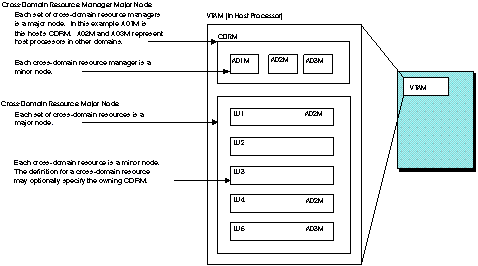 z/OS Communications Server: SNA Network Implementation Guide
z/OS Communications Server: SNA Network Implementation Guide
 z/OS Communications Server: SNA Network Implementation Guide
z/OS Communications Server: SNA Network Implementation Guide
|
Previous topic |
Next topic |
Contents |
Contact z/OS |
Library |
PDF
Identifying VTAMs in other domains (CDRMs) z/OS Communications Server: SNA Network Implementation Guide SC27-3672-01 |
|
|
A cross-domain resource manager (CDRM) is the part of an SSCP that supports cross-domain session setup and takedown. Before logical units in one domain can have cross-domain sessions with logical units in another domain, an SSCP-SSCP session must be established between the SSCPs of the two domains. For an SSCP-SSCP session to exist, VTAM® must know about all cross-domain resource managers with which it will communicate. You must define to VTAM its own cross-domain resource manager and all other cross-domain resource managers in the network. The cross-domain resource manager that represents the SSCP in your domain is called the host cross-domain resource manager. The cross-domain resource managers that represent the SSCPs in other domains are called external cross-domain resource managers. Thus, to have a session between two SSCPs, define two cross-domain resource managers to each VTAM: one for the host and one for the external cross-domain resource manager. You file these definitions in a CDRM major node. Each cross-domain resource manager is a minor node. One or more major nodes can be used to define cross domain resource managers. Each CDRM major node is defined with a VBUILD definition statement, and each minor node is defined with a CDRM definition statement. Figure 1 shows two types of major and minor nodes in a multiple-domain network. Figure 1. Major and minor nodes in multiple-domain
environment
 Following is an example of major node CDRM for host A01M. The same definition set can be
used at A02M and A03M. In this case, the definition set is at A01M.
Thus, A01M is the host cross-domain resource manager and A02M and
A03M are external cross-domain resource managers.
Each CDRM minor node definition includes its network address and its initial status (active by default, or inactive). CDRM minor nodes are assigned to the subarea address of the appropriate host. You can use the same set of CDRM definition statements for the entire network. Each VTAM uses the subarea specified on the CDRM definition statements to determine which definition statement defines its own host cross-domain resource manager. If the subarea on a CDRM definition statement matches the host subarea, VTAM uses the operands on this CDRM definition statement that apply to the host cross-domain resource managers and ignores operands that apply to external cross-domain resource managers. If the subarea on a CDRM definition statement does not match its host subarea, VTAM assumes that this CDRM definition statement applies to an external cross-domain resource manager. VTAM then uses only the operands that apply to external cross-domain resource managers. When defining the host cross-domain resource manager, you can specify whether the host cross-domain resource manager is authorized to dynamically define cross-domain resources. If the host cross-domain resource manager and an external cross-domain resource manager are authorized in a VTAM domain, the other-domain SSCP can request a session setup for a logical unit for which no cross-domain resource (CDRSC) was defined. The receiving SSCP handles the request by dynamically creating a temporary CDRSC definition for the logical unit. Using dynamic definition of cross-domain resources can greatly reduce the number of definitions required in a multiple-domain network. The default for the CDRDYN start option is YES, enabling dynamic definition of cross-domain resources. The CDRDYN operand can be coded on the host CDRM definition statement, but the CDRDYN start option overrides it. Also code CDRSC=OPT on external CDRM definition statements whose resources you want VTAM to dynamically define. The CDRSC operand is meaningful only on CDRM definition statements for external CDRMs. The preceding example, which illustrates a CDRM major node, defines
CDRMs that use different dynamic CDRSC options. The resulting capabilities
of and restrictions on dynamic cross-domain resource definition are
as follows:



|
 Copyright IBM Corporation 1990, 2014 Copyright IBM Corporation 1990, 2014 |